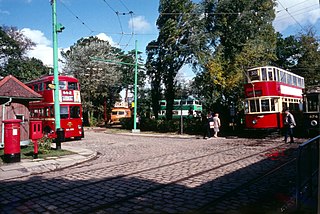
The East Anglia Transport Museum is an open-air transport museum, with numerous historic public transport vehicles. It is located in Carlton Colville a suburb of Lowestoft, Suffolk. It is the only museum in the country where visitors can ride on buses, trams and trolleybuses, as well as a narrow-gauge railway.

Boro'line Maidstone, previously Maidstone Borough Council Transport was a municipal bus operator in Maidstone and the surrounding villages. Maidstone Borough Council Transport was formed in 1974 from Maidstone Corporation Transport following local government reorganisation. In 1986 Boro'line Maidstone was formed as an arm's length company of Maidstone council from the operations of Maidstone Borough Council Transport. The company had a brief London operation. Following financial difficulties, the London operation was sold to Kentish Bus, and after a period of administration, the assets of the Maidstone operation was sold to Maidstone & District in 1992.

Maidstone & District Motor Services was a bus company based in Maidstone, Kent. The company operated bus and coach services in Mid and West Kent and East Sussex from 1911 until 1998. The company's surviving operations were absorbed into Arriva Southern Counties.
The Mexborough and Swinton Traction Company was the name adopted by the Mexborough & Swinton Tramways Company in 1929 following the introduction of trolleybuses on all its routes. It operated in the West Riding of Yorkshire, England, over routes serving Manvers Main Colliery, Wath upon Dearne and the towns of Rotherham, Rawmarsh, Swinton, Mexborough, Conisbrough and the estate at Conanby.

The Adelaide trolleybus system formed part of the public transport network in Adelaide, South Australia from 1932 until 1963.
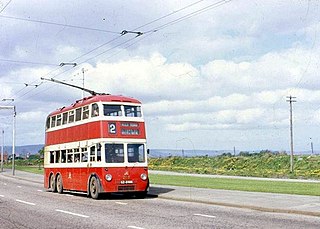
The Belfast trolleybus system served the city of Belfast, Northern Ireland. It was the only trolleybus system built in Ireland. Opened on 28 March 1938, it gradually replaced the city’s tramway network.
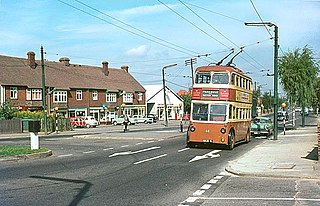
The Maidstone trolleybus system once served Maidstone, the county town of Kent, England. Opened on 1 May 1928, it gradually replaced the Maidstone tramway network.

The Nottingham trolleybus system once served the city of Nottingham, in the county of Nottinghamshire, England. Opened on 10 April 1927, it gradually replaced the Nottingham tramway network.

The trolleybus system in Manchester, England, opened on 1 March 1938, and gradually replaced certain routes of the Manchester tramway network. Manchester was a belated convert to trolleybuses having already started a programme of tram to diesel bus conversion in the mid-1930s and this, overall, continued to be the preferred option for tram conversion that was completed in 1949.

The Reading trolleybus system served the town of Reading in the English county of Berkshire and was owned by Reading Corporation, who had operated an electric tramway since 1901. As there was a need for major refurbishment of the tramway in the 1930s, they decided to replace it with a trolleybus network. The first route was converted on 18 July 1936, and by mid 1939, trolleybuses were running over most of the tramway routes, with the last tram running on 20 May. By the standards of the various now-defunct trolleybus systems in the United Kingdom, the Reading system was a moderately sized one, with a total of four routes, and a maximum fleet of 63 trolleybuses, a size that lasted from 1 December 1950 to 27 March 1952.
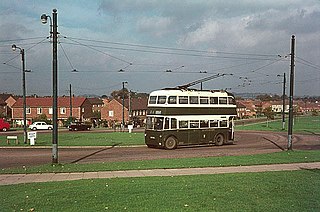
The Derby trolleybus system once served Derby, the former county town of Derbyshire in central England. The trolleybus service started in 1932 and ran until 1967.
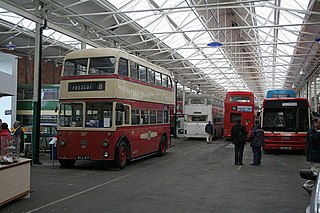
The St Helens trolleybus system once served St Helens, Merseyside, north west England. Opened on 11 July 1927, it gradually replaced the St Helens tramway network.

The Teesside trolleybus system once served the conurbation of Teesside, in the North East of England. Opened on 8 November 1919, it was unusual in being a completely new system that was not replacing any previously operating tramway network.

The Bournemouth trolleybus system once served the town of Bournemouth, then in Hampshire, but now in Dorset, England. Opened on 13 May 1933, it gradually replaced the Bournemouth tramway network.

The Walsall trolleybus system once served the town of Walsall, then in Staffordshire, but now in West Midlands, England. Opened on 22 July 1931, it gradually replaced the Walsall Corporation Tramways network.

The Grimsby trolleybus system once served the seaport of Grimsby, in Lincolnshire, England. Opened on 3 October 1926, it gradually replaced part of the Great Grimsby Street Tramways, a tramway that had served both Grimsby and the neighbouring holiday resort of Cleethorpes. It was closed on 4 June 1960.

The Cleethorpes trolleybus system once served the holiday resort of Cleethorpes, in Lincolnshire, England. Opened on 18 July 1937, it replaced part of the Great Grimsby Street Tramways, a tramway that had served both Cleethorpes and the neighbouring seaport of Grimsby. It was closed on 4 June 1960.

The Hastings trolleybus system once served the town of Hastings, East Sussex, England. Opened on 1 April 1928, it gradually replaced the Hastings tramway network, with the first route to be converted that from the Fishmarket to Hollington, East Sussex and the last, the circular route. Tram replacement cost £1,383 per mile, but increased average speed from 7.5 to over 10 mph and cut costs from 13d to 10d per mile.

The Doncaster trolleybus system once served the town of Doncaster, South Yorkshire, England. Opened on 22 August 1928, it gradually replaced the Doncaster Corporation Tramways. By the standards of the various now-defunct trolleybus systems in the United Kingdom, the Doncaster system was a moderately sized one, with a total of 6 routes, all radiating out from the town centre, and a maximum fleet of 47 trolleybuses. The Bentley route was the first to close, on 12 February 1956, and the Beckett Road route was the last to go, on 14 December 1963.

The Brighton trolleybus system formerly served the town of Brighton, East Sussex, England. Opened on 1 May 1939, it gradually replaced the Brighton Corporation Tramways network.



























